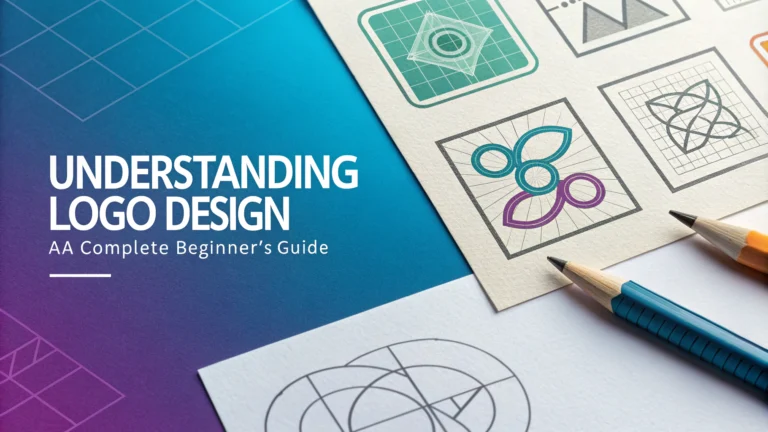A well-designed logo serves as the visual foundation of your brand identity, making an immediate impact on potential customers.
The Basics of Logo Design
The most effective logos combine simplicity with memorability, ensuring they work across all platforms and sizes.
- Scalability: Must look clear from billboard size to favicon
- Versatility: Should work in color and black & white
- Uniqueness: Sets your brand apart from competitors
- Relevance: Reflects your industry and brand values
Essential Design Elements
Every successful logo incorporates these key components:
- Typography: Choose fonts that match your brand personality
- Color: Select shades that trigger the right emotional response
- Shape: Use forms that communicate your brand message
- Space: Balance elements with proper spacing
Logo Types to Consider
| Type | Best For |
|---|---|
| Wordmark | Companies with strong, simple names (Google, Coca-Cola) |
| Symbol | International brands needing universal recognition (Apple, Nike) |
| Combination Mark | New businesses wanting flexibility (Burger King, Adidas) |
| Monogram | Companies with long names (HBO, IBM) |
Practical Design Tips
Start with black and white designs before adding color to ensure the logo works in its simplest form.
- Sketch multiple concepts before moving to digital
- Test your logo at different sizes
- Get feedback from target audience members
- Check for cultural sensitivity
- Research competitor logos to ensure distinctiveness
Tools and Resources
Professional design software options include:
- Adobe Illustrator: Industry standard ($20.99/month)
- Affinity Designer: One-time purchase alternative ($54.99)
- Inkscape: Free, open-source vector editor
Common Mistakes to Avoid
- Using too many colors or fonts
- Following trendy designs that will date quickly
- Making the design too complex
- Copying other brands too closely
- Forgetting to check trademark availability
For professional logo design services, consider working with experienced designers through platforms like Behance or Dribbble.
Working with Professional Designers
When hiring a professional designer, establish clear communication and expectations from the start.
- Provide detailed brand guidelines
- Set realistic timelines
- Discuss revision policies upfront
- Be specific about deliverable formats
Logo File Formats
Request these essential file formats for various applications:
| Format | Use Case |
|---|---|
| AI/EPS | Source files for editing |
| SVG | Web and responsive design |
| PNG | Digital applications with transparency |
| Print materials |
Implementation Guidelines
Maintain brand consistency by creating a logo usage guide specifying:
- Minimum size requirements
- Clear space rules
- Color variations
- Prohibited modifications
Conclusion
A well-designed logo is a crucial investment in your brand’s future. Focus on creating a timeless, versatile design that communicates your brand’s core values and maintains its impact across all platforms and applications. Whether working with professionals or designing in-house, prioritize simplicity, memorability, and proper implementation to build a strong visual foundation for your brand.
FAQs
- What exactly is a logo design and why is it important for my business?
A logo design is a unique graphic symbol or mark that represents your brand’s identity. It’s crucial for business recognition, professional appearance, and brand memorability, serving as the visual cornerstone of your company’s marketing efforts. - How much should I expect to pay for a professional logo design?
Professional logo design costs can range from $300 to $2500+ for small businesses, while enterprise-level branding can cost $10,000+. The price varies based on designer experience, complexity, revisions, and deliverables included. - What are the essential elements of an effective logo design?
The essential elements include simplicity, scalability, memorability, relevance to the industry, appropriate color choice, and versatility across different mediums and applications. - How long does the logo design process typically take?
A professional logo design process typically takes 2-4 weeks, including research, conceptualization, initial designs, client feedback, revisions, and final file delivery. - What file formats should I receive with my final logo design?
You should receive vector files (AI, EPS, SVG), raster files (JPEG, PNG), and various color versions (full color, black, white). Vector files are essential for scalability without quality loss. - Should my logo be trendy or timeless?
A logo should primarily aim for timelessness over current trends. While incorporating modern elements is acceptable, the core design should remain relevant for 5-10 years to maintain brand consistency and recognition. - What’s the difference between a wordmark, symbol, and combination mark?
A wordmark is typography-based (like Google), a symbol is an icon or image (like Apple’s apple), and a combination mark features both text and a symbol (like Adidas). Each type serves different branding purposes. - How many colors should I use in my logo design?
Professional logos typically use 1-3 colors maximum. Using fewer colors ensures versatility, reduces printing costs, and makes the logo more memorable and easier to reproduce across different mediums. - Can I copyright or trademark my logo design?
Yes, logos can be protected through trademark registration. While copyright exists automatically upon creation, registering a trademark provides stronger legal protection for your brand identity. - What makes a logo design memorable?
Memorable logos combine simplicity with uniqueness, use distinctive design elements, maintain visual balance, and create an emotional connection while clearly representing the brand’s values and personality.







